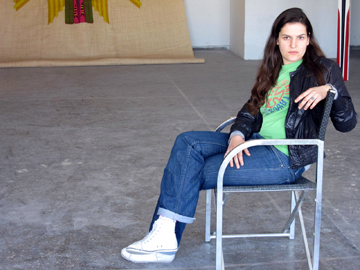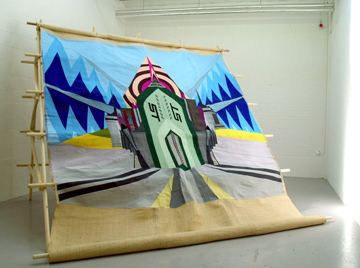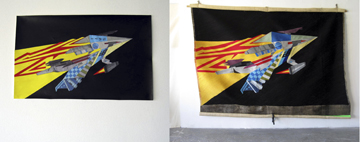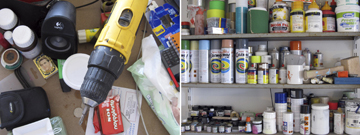With this post, we introduce a new bi-weekly monthly column to the Art21 Blog: Inside the Artist’s Studio, written by Athens-based artist and contributor Georgia Kotretsos. Here’s an overview, in her words:
…A haven, an office, a meeting place, a thinking space where the working hours spent by an artist may easily be considered illegal by outsiders. It’s the space where one composes oneself and tunes in with one’s surroundings, where the placing of one’s own paraphernalia is sacred but at other times simply allowed to rest in ordered chaos. The space where light-footed apprentices gracefully serve the creative process. A place where the scent of art and habits of an artist pierce one’s senses. A space where an artist collects his/her thoughts and then scatters them around freely to be cast into artworks.
Can this really be true? Do we still latch onto romantic notions of what a studio is or can be? Or have they involved over the years along with artists themselves?
For this reason, I am setting out to meet with two one artist a month to discuss their studio practice, whether that is in the streets, at a computer, in their living space, etc. Inside the Artist’s Studio will introduce you to a number of artists’ work. Together we’ll discover where some of today’s art is made.

- Artist Dafni E. Barbageorgopoulou at her studio in Keramikos, Athens, Greece
At Dafni E. Barbageorgopoulou’s studio, art is in the making. Right on Athens’s Keramikou Street, the nest of her creative energy previously served as an Asian restaurant. To this day, evidence of this is found in the dried-up noodles stuck on the tiles on the back wall, apparently there to stay.
There is a boyish, fresh quality in Barbageorgopoulou’s work. Her tapestries are generous gestures of art and her personality reflects this very liberty by drawing from a wide range of influences, such as from Cycladic to Mexican art, science fiction to dreams, geometry to poetry, origami to monumental architecture. A fusion of eclectic ideas, disciplines, and genres make up the profile of her work.
Dafni holds a BFA in sculpture from the Athens School of Fine Arts and an MA in Sculpture from the Royal College of Art in London (2006). As we speak, she is off to the Kunstlerhaus Bethanien International Studio Program in Berlin for a year.
I visited her studio several times—working with her on this post was a pure joy. She is one authentic lady and I’m very please to have her kick off the “Inside the Artist’s Studio” column on this site.
Georgia Kotretsos: Take us through the development of your practice over the past few years and then talk to us a little bit about how these three tapestries (Mother, 2006; P, 2008; Space Kraft, 2009) came to be?

"P," 2008. 350 x 400 x 250 cm
Dafni E. Barbageorgopoulou: My practice focuses on the mapping of bodily experiences, which are then transferred into two-dimensional forms (patterns, collages). These maps/motifs (as in the case of Mother) are consequently being transferred as objects/installations into space (as with P).
At the center of this process is the way in which the body tunes into creative flow. A sense of energy and repetitive movement conducts new rhythms. I am interested in how the final object or situation preserves the levels of energy released during the process of making. This release creates a certain void around the work activating the field around it. The end result becomes lighter, shifts scale, and engages with new materials. Each project is an integral part of a bigger synthesis.
GK: What role do dreams and futurism play in your work and how do you combine the two in the actual tapestries?

Left: Preliminary drawing of tapestry. Right: Tapestry entitled "Space Kraft," 2009. 220 x 180 cm
DEB: Dreams and journeys are the raw material of my practice. An essential part of this material is gathered from a detailed record of my dreams during the periods I travelled. The spatial and temporal passages performed during journeys resonate in non-linear, organic growth and the narrative sequences dictated by dreams. Reminiscent of a filmic experience, this mesh of images and places is released by memory and involuntary thoughts. This process does not exclude my experience from the periods when I am not traveling; rather it contains and embosses it. As such, my artistic research aims to explore ways to reintegrate ritual into art by analyzing how sensed, rather than understood, correspondences between memory and action become functional and thus expressive tools within art practice. I propose ways of combining constructive, synthetic aspects of artmaking with instinctive responses to patterns emerging from non-verbal realms. I aim to critically review how a generic function of visual art is to activate such mental primordial imagery and structures to promote communicative aspects of the discipline.
Out of the interaction of dreams with journeys derive images, phrases, and coincidences that feed my work and clarify my inquiries in an open-ended dialogue. I am consciously following and developing these instinctual drives. Specific works like Mother, P, Space Kraft, and Star Kite have been created within this process. The depiction of these relations is based on futuristic references through the use of geometrical shapes, recurring patterns, and strong colors.
As in a dream, in my work I am describing an experience of space where time has contracted, where causalities can be overcome, and creative forces are at hand. There is a tension between action and image as experienced in the activity of the journey and the images of the dream. My work is acting like a storyteller of the modalities of both experiences, shifting between sensations of time and space. The unrealized, immaterial fabric of dreams is transposed into the imaginary narratives running throughout my work.
________________________________________________________
GK: I had the opportunity to discuss the process of these works at her studio. So, let’s hear it straight from Dafni.
Dafni E. Barbageorgopoulou discusses the process of making the three tapestries:
[youtube:https://www.youtube.com/watch?v=-GXT96P_SH4]
GK: What’s your current studio setting and your relationship to that space?

Dafni E. Barbageorgopoulou's studio views
Currently my studio space is located in Keramikos, in downtown Athens. It’s an affordable 130 sq. meter space, which takes up the entire second floor of the six-floor building, facing towards a big square. There is plenty of daylight coming through, which makes it very pleasant to work there in the mornings. The space of this studio is divided into three rooms: a) the main central room, which is the space for producing all the artworks; b) a computer and printing room; as well as c) a storage space. Since I use it only as a working space, I spend 8 to 11 hours there on daily basis. It is not an ideal space for sculpture since the ceiling is not high enough but it is a very good space for site-specific installations.

Left: work surface made of 1. food supplements 2. collection of chopsticks 3. eccentric matchbox 4. table speakers 5. camera case 6. cellphone 7. half a bar of an ION classic chocolate 8. gluestick 9. drill 10. marker and 11. wet wipes. Right: Pigments, sprays, containers nicely stored.
That’s a wrap!




Pingback: Inside the Artist’s Studio: The Studio Reader and the SAIC Summer Studio | Art21 Blog